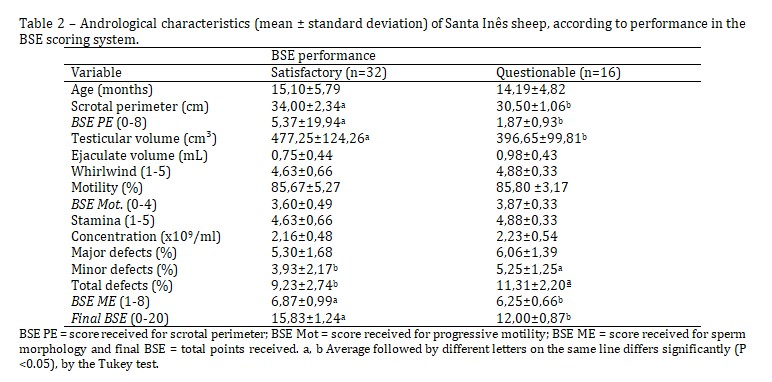Use of the breeding soundness examination scoring system in Santa Inês and Dorper rams
DOI :
https://doi.org/10.21708/avb.2020.14.2.8691Résumé
This study evaluates the use of the Breeding Soundness Evaluation (BSE) scoring system in Santa Inês and Dorper rams. 89 Santa Inês (n = 48) and Dorper (n = 41) rams were submitted to andrological examination and classified with the BSE scoring system. The proportion of Santa Inês sheep with satisfactory and questionable performance in the BSE scoring system was 66.6% (32/48) and 33.34% (16/48), respectively. The average BSE value was higher (p < 0.05) in rams with satisfactory performance (15.83 ± 1.24), compared to those with questionable performance (12.00 ± 0.87). The proportion of Dorper rams with excellent and satisfactory performance in the BSE scoring system was 26.83% (11/41) and 73.17% (30/41), respectively. The average value of BSE was higher (p<0.05) in rams with excellent performance (19.29 ± 0.45) in relation to those with satisfactory performance (16.77 ± 0.99). In Santa Inês sheep there was a strong positive correlation between BSE and scrotal perimeter e (r = 0.75; p < 0.01) and a moderate negative correlation between BSE and sperm morphology (r = -0.52; p < 0.01). In Dorper sheep there was a strong positive correlation between BSE and scrotal perimeter (r = 0.69; p < 0.01) and a moderate negative correlation between BSE and sperm morphology (r = -0.60; p < 0.01). BSE can therefore be used as a complementary tool for andrological examination. It was possible to classify and rank Santa Inês and Dorper sheep according to the parameters adopted by BSE.
Téléchargements

Téléchargements
Publié-e
Numéro
Rubrique
Licence
Autores que publicam na Acta Veterinaria Brasilica concordam com os seguintes termos: a) Autores mantém os direitos autorais e concedem à revista o direito de primeira publicação, com o trabalho simultaneamente licenciado sob a Licença Creative Commons Attribution que permite o compartilhamento do trabalho com reconhecimento da autoria e publicação inicial nesta revista. b) Autores têm autorização para assumir contratos adicionais separadamente, para distribuição não-exclusiva da versão do trabalho publicada nesta revista (ex.: publicar em repositório institucional ou como capítulo de livro), com reconhecimento de autoria e publicação inicial nesta revista. c) Autores têm permissão e são estimulados a publicar e distribuir seu trabalho online (ex.: em repositórios institucionais ou na sua página pessoal) a qualquer ponto antes ou durante o processo editorial, já que isso pode gerar alterações produtivas, bem como aumentar o impacto e a citação do trabalho publicado (Veja O Efeito do Acesso Livre).


 Esta obra está licenciada com uma Licença
Esta obra está licenciada com uma Licença 